El achiote ó Bixa Orellana es una planta que pertenece a la familia Bixaceae, es
conocida como achiotl, cultivado desde la época precolombina proviene de
México, América Central, Colombia, Ecuador, Venezuela y los Andes de Perú.
De esta planta se aprovechan sus frutos que son ricos en carotenoides y
flavonoides (pigmentos orgánicos), en su interior guardan alrededor de 30 a 40
semillas envueltas por una capa de color rojo.
Su semilla fue utilizada por estas culturas tradicionalmente para condimentar sus
alimentos, como colorante para telas, códices, pinturas y como planta medicinal.
El significado de la tinta es un fluido compuesto por un vehículo que transporta
pigmentos y aditivos, capaz de mantenerse como tal en un cuerpo impresor y que
cambia a estado sólido en contacto con el sustrato.
En la actualidad existen diversas tintas desde las indelebles hasta las invisibles,
todo dependerá del reactor químico la acción del calor o la adición de una materia
por ejemplo las tintas de los bolígrafos son fabricados a partir de resinas fenólicas
y poliestireno, todos ellos, son elaborados con distintos componentes químicos
como el ácido tánico o el glicerol, mezclados con distintos tintes para que así
podamos escribir.
Así que utilizando el achiote como pigmentador decidimos elaborar un bolígrafo a
base de su tinta, mezclando las semillas y probando con elementos como el
alcohol y agua realizando varias pruebas para determinar si el proyecto es viable y
poder aminorar el uso de bolígrafos y así ayudar al medio ambiente reciclando el
envase.
Link para observar el engargolado
Link para observar la lona
Las tintas para bolígrafo que solemos utilizar están hechas de tintes, disolventes y pigmentos que pueden tener cierto grado de toxicidad, por ejemplo, pueden contener dióxido de titanio y petróleo, entre otros. En ocasiones los niños pueden tener contacto con la piel e incluso ingerir por accidente, lo que puede ocasionar irritación, infecciones o intoxicación. Aunque existen otras opciones en el mercado, estas pueden tener un mayor costo o no ser de fácil acceso para la población en general.
El achiote es un tipo de árbol cultivado desde la época precolombina y proveniente de México, en su interior guardan alrededor de 30 y 40 semillas envueltas por una capa de color rojo. Esta especie crece en las zonas cálidas de México, los estados productores son Yucatán y Quintana Roo. Tabasco, Campeche y Yucatán son los estados de la República donde más se cultiva el achiote y, aunque existen dos tipos de semilla, la más demandada es la colorada porque es utilizada en la elaboración de la cochinita pibil, un platillo típico de Yucatán. Su principal característica es que puede adaptarse a diferentes tipos de clima, suelo y altitud. Los arbustos comienzan su producción comercial cuando tienen entre tres y cuatro años de edad. En promedio, una plantación se logra aprovechar por un periodo de 12 años, aunque puede variar de acuerdo con las condiciones del suelo y clima. Los frutos se utilizan para dar sabor y color a la comida, de las semillas se obtiene un colorante conocido como Bixina, éste se encuentra en la cubierta exterior del fruto que una vez extraído Los pueblos originarios de Centro y
Sudamérica lo utilizan como pintura corporal y facial para sus rituales religiosos actualmente su semilla se usa tradicionalmente como condimento, como colorante y como planta medicinal. Este condimento se puede encontrar en platillos de toda América Latina, Caribe y hasta de Filipinas. Durante la época prehispánica, el achiote se utilizó poco debido a que, por su intenso color rojo, se le relacionaba con la sangre. Sin embargo, los mayas supieron aprovechar por un lado su sabor, creando una bebida para sus rituales, y por otro, su color ya que, de acuerdo con una leyenda maya, lo utilizaron como pigmento para pintar códices. Después del descubrimiento de América, el achiote se llevó a Europa donde lo llamaron “rocou” y lo utilizaban para teñir pieles, lana, plumas, huesos, y para la coloración de mantequilla, arroz y quesos como el Cheddar o Tipo Americano. La primera tinta de la historia estaba elaborada con hollín, elementos aromáticos y pigmentos vegetales naturales.
Elaborar una tinta natural a base de achiote para bolígrafos
Alrededor de el mundo existen diferentes especies que gozan de un uso especial como es el caso del achiote que tiene numerosos beneficios.
El achiote contiene semillas que también se les conoce como bixina Orellana estas semillas se emplean a modo de condimento de cocina que le da una coloración rojiza a la comida.
Para dar un uso distinto al achiote y aprovechando la coloración que posee, hemos decidido hacer una tinta en donde se disminuya el uso de sustancias tóxicas que pueden ser dañinas tanto para el ambiente como para las personas.
Si logramos elaborar una tinta a base de achiote podremos utilizarla para rellenar bolígrafos.
Como rellenar la pluma
Materiales
Procedimiento
Como hacer la tinta
Materiales
Procedimiento

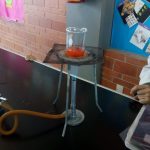
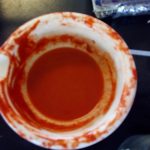
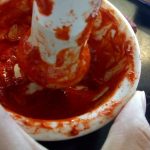
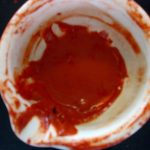

Obtuvimos una tinta que efectivamente pinta de color rojizo sin embargo todavía no logramos que funcione dentro de el cartucho ya que hay que limpiar bien la pluma ya que al no limpiarla bien la tinta no baja por completo y hace que no pinte afortunadamente si salio la tinta entonces solo hay que buscar una manera de que sirva dentro de la pluma.
https://youtu.be/Mw5TVmw1LZo
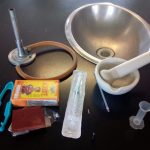

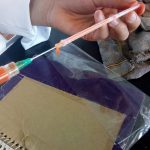
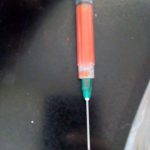
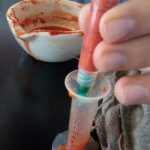
De acuerdo a los resultados obtenidos con la tinta de achiote podemos obtener grandes beneficios como es una tinta natural y menos tóxicos así podremos reutilizar los envases de las plumas que ya se han acabado, y economizar y ayudar al ambiente, sin embargo no es tan sencillo rellenar las plumas ya que hay que limpiar por completo el envase y no tenemos los instrumentos adecuados. Sin embargo el uso de la tinta es adecuado para papel, tela, y su uso en madera y cartón no fue determinado ya que la madera absorbe la mayor cantidad de la tinta y el cartón se humedece
Podemos disminuir el uso constante de plástico como es la reutilización de cartuchos de plumas ya se puede generar tinta con materiales naturales, así como el achiote un condimento natural que suelta una tinta roja y que no afectará al planeta
Achiote.org,2019, Achiote,propiedades,beneficios,nutrientes y usos disponible en https://www.achiote.org/ el día 22 de Enero del 2020.
Inprentajoscar.blog 2018 La tinta contaminante que riegos tiene a la salud 2017 disponible en https://imprentajoscar.com/blog/30_tinta-contaminante-riesgos-salud el día 24 de Enero
Caligrafía arte y diseño Tintas naturales de achiote 2013 disponible en http://caligrafiaarteydiseo.blogspot.com/2013/02/tintas-base-de-achiote.html el día 30 de Enero
WordPress Tintas naturales consultado 2018 consultado en https://tintesnaturales.wordpress.com/2012/09/29/tenido-con-achiote/ el día 5 de Febrero
Medlineplus Consecuencias de la tinta 2017 consultado en https://medlineplus.gov/spanish/ency/article/002791.htm el día 13 de Febrero
The achiote or BixaOrellana is a plant that belongs to the family
Bixacea, is known as achiotl, cultivated since preColumbian times it comes from
Mexico, Central America, Colombia, Ecuador, Venezuela and the Andes of Peru.
From this plant its fruits are used that are rich in carotenoids and flavonoids
(organic pigments) inside they store about 30 to 40 seeds wrapped by a red layer .
His seed was traditionally used by these cultures to spice up his food, such as
dyeing for fabrics, codices, paintings and medicinal plant .
The meaning of the ink is a fluid composed of a vehicle that carries
pigments and additives, capable of staying as such on a printer body and
switching to solid state in contact with the substrate.
Currently there are various inks from the indelible to the invisible, everything will de
pend on the chemical reactor the action of the heat,
or the addition of a material for example the inks of pens are manufactured from ph
enolic and polystyrene resins,
all of them, are made with different chemical components such as tannic acid or gly
cerol, mixed with different dyes so that we can write.
So using achiote as a pigmenter we decided to make a pen based on its ink , ,
mixing the seeds and testing with elements such as alcohol and water by conductin
g various tests to determine if the project is feasible
to be able to reduce the use of pens and thus help the environment by recycling th
e packaging
The pen inks we usually use are made of dyes, solvents and pigments that may have a certain degree of toxicity, for example, they may contain titanium dioxide and petroleum, among others.
Sometimes children may have contact with the skin and even ingest by accident, which can cause irritation, infections or poisoning.
Although, there are other options in the market, these may have a higher cost or may not be easily accessible to the general population.
Achiote is a type of tree cultivated since pre-Columbian times and from Mexico, inside they keep around 30 and 40 seeds wrapped in a red layer. This species grows in the warm areas of Mexico, the producing states are Yucatan and Quintana Roo. Tabasco, Campeche and Yucatan are the states of the Republic where achiote is most cultivated and, although there are two types of seed, the most demanded is the red one because it is used in the production of cochinita pibil, a typical Yucatan dish. Its main feature is that it can adapt to different types of climate, soil and altitude. Shrubs begin commercial production when they are three to four years old. On average, a plantation can be used for a period of 12 years, although it can vary according to soil and climate conditions. The fruits are used to give flavor and color to the food, from the seeds a colorant known as Bixina is obtained, this is found in the outer covering of the fruit that once extracted The original peoples of Centro and
South America uses it as a body and face paint for their religious rituals. Currently, its seed is traditionally used as a condiment, as a colorant and as a medicinal plant. This seasoning can be found in dishes throughout Latin America, the Caribbean and even the Philippines. During the pre-Hispanic era, achiote was little used because, due to its intense red color, it was related to blood. However, the Mayans knew how to take advantage of its flavor, on the one hand, creating a drink for their rituals, and on the other, its color since, according to a Mayan legend, they used it as a pigment to paint codices. After the discovery of America, achiote was taken to Europe where they called it “rocou” and used it to dye skins, wool, feathers, bones, and for coloring butter, rice, and cheeses such as Cheddar or American Type. The first ink in history was made with soot, aromatic elements and natural plant pigments.
To prepare a natural ink based on annatto for pens
Around the world there are different species that enjoy special use such as the achiote that has numerous benefits.
The achiote contains seeds that are also known as bixina Orellana. These seeds are used as a cooking seasoning that gives the food a reddish color.
To give a different use to the achiote and taking advantage of the color it has, we have decided to make an ink where the use of toxic substances that can be harmful to both the environment and people is reduced.
If we manage to make an ink based on annatto, then we would fill pens
How to fill the pen
materials
ink
Common syringe
Needle
Process
Remove the tip of the pen
Insert the natural ink created with the syringe
Entering the ink little by little is important that it does not contain bubbles because when painting the ink it will not be able to go down since it has air
Do not fill the entire tube as it can be passed and it can be strapped, it is recommended to put two fingers so that it does not come out
Finally replace the tip
How to make the ink
materials
200 grams of annatto stick
Mortar
Strainer
A 250 ml beaker
200ml of salt water
100 ml of alcohol
Process
Grind the annatto in case it is very hard to boil it with water over low heat in the beaker for 10 minutes
When a paste is made, pour 10 ml of alcohol with 10 ml of salted water
The ink has to have a consistency if you have groups to strain it so that it does not have them and the ink comes out more easily






We obtained an ink that effectively paints a reddish color, however we still have not managed to work it inside the cartridge since the pen has to be cleaned well since when it is not cleaned well, the ink does not drop completely and causes it to not paint fortunately if the ink came out





According to the results obtained with annatto ink, we can obtain great benefits as it is a natural ink and less toxic, so we can reuse the containers of the pens that have already finished, and save and help the environment, however it is not so simple fill the pens as the container must be completely cleaned and we do not have the appropriate instruments. However, the use of ink is suitable for paper, fabric, and its use on wood and cardboard was not determined as the wood absorbs the greatest amount of ink and the cardboard becomes damp.
It can reduce the constant use of plastic using an effective solution that is the reuse of packaging and you can generate ink with natural materials that do not drastically affect the planet.
Achiote.org,2019, Achiote,propiedades,beneficios,nutrientes y usos disponible en https://www.achiote.org/ el día 22 de Enero del 2020.
Inprentajoscar.blog 2018 La tinta contaminante que riegos tiene a la salud 2017 disponible en https://imprentajoscar.com/blog/30_tinta-contaminante-riesgos-salud el día 24 de Enero
Caligrafía arte y diseño Tintas naturales de achiote 2013 disponible en http://caligrafiaarteydiseo.blogspot.com/2013/02/tintas-base-de-achiote.html el día 30 de Enero
WordPress Tintas naturales consultado 2018 consultado en https://tintesnaturales.wordpress.com/2012/09/29/tenido-con-achiote/ el día 5 de Febrero
Medlineplus Consecuencias de la tinta 2017 consultado en https://medlineplus.gov/spanish/ency/article/002791.htm el día 13 de Febrero